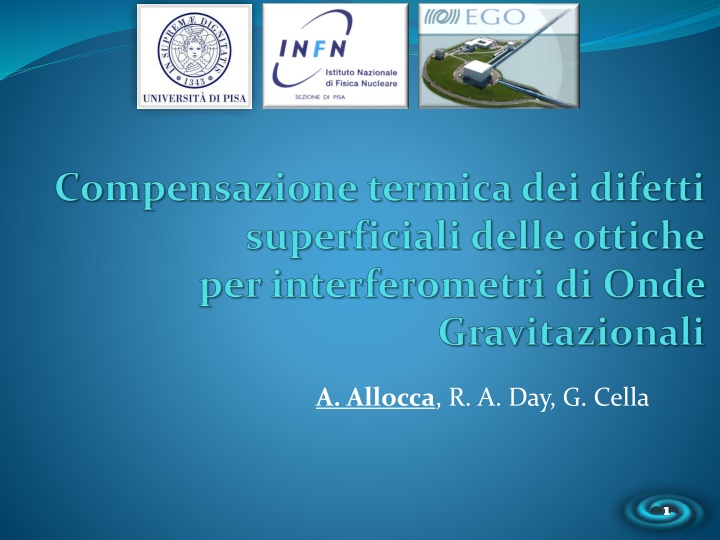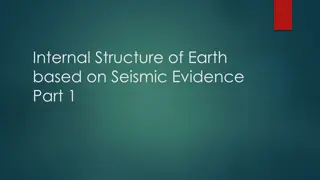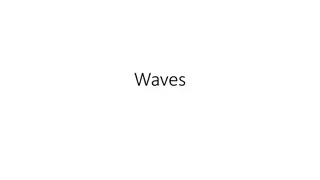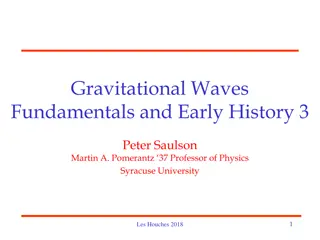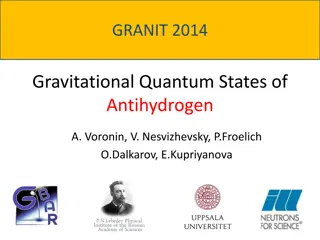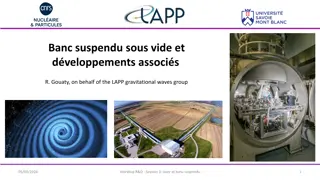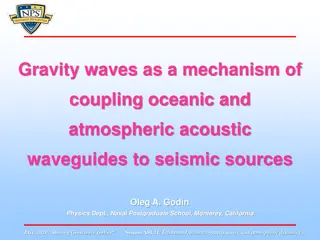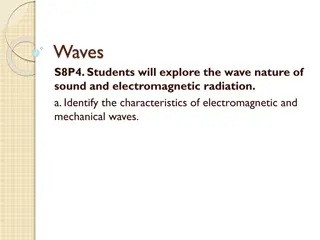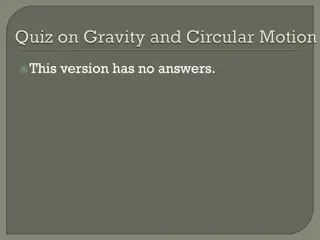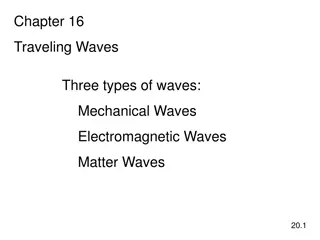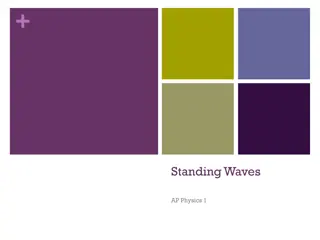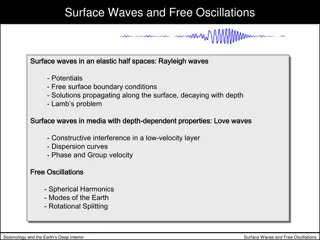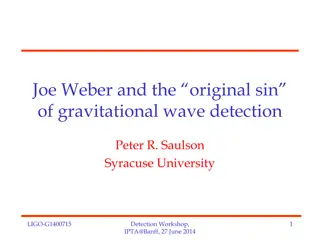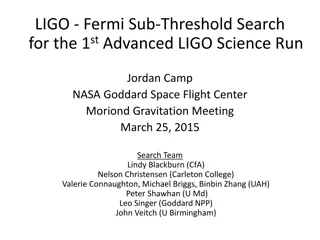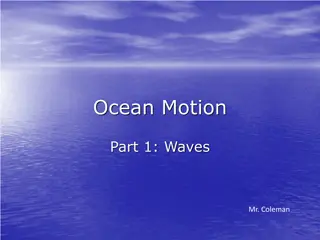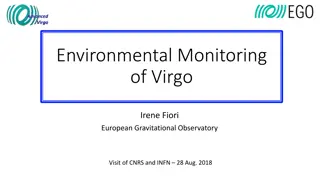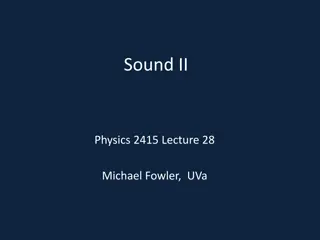Detecting Gravitational Waves with Interferometers
Gravitational waves, predicted by Einstein's Theory of General Relativity, are incredibly weak ripples in spacetime that can be detected using interferometers. This method involves using suspended mirrors to reproduce free-fall conditions, enhancing signals through various techniques like Michelson Interferometry, Fabry-Perot cavity, and heterodyne detection. The Advanced Virgo project aims to achieve design sensitivity by ensuring perfect destructive interference between recombining beams.
Download Presentation

Please find below an Image/Link to download the presentation.
The content on the website is provided AS IS for your information and personal use only. It may not be sold, licensed, or shared on other websites without obtaining consent from the author.If you encounter any issues during the download, it is possible that the publisher has removed the file from their server.
You are allowed to download the files provided on this website for personal or commercial use, subject to the condition that they are used lawfully. All files are the property of their respective owners.
The content on the website is provided AS IS for your information and personal use only. It may not be sold, licensed, or shared on other websites without obtaining consent from the author.
E N D
Presentation Transcript
Outline Detecting Gravitational Waves with interferometers The problem of mirror aberrations and the corrective thermal compensation devices for GW detectors New idea for thermal compensation: CHRAC Conclusions 2
Outline Detecting Gravitational Waves with interferometers The problem of mirror aberrations and the corrective thermal compensation devices for GW detectors New idea for thermal compensation: CHRAC Conclusions 3
Gravitational Waves and their detection Einstein s Theory of General Relativity foresees the existence of Gravitational Waves Effect of a GW on free-falling masses y L ?? ? x L z Very weak amplitude: 10 21 The distance between two masses separated by ~Km will change by ?? ?? ??m That is comparable to a hair s-width change in the distance from the Sun to Alpha Centauri, its nearest star . 4
?? ? Michelson Interferometry to detect GWs Use an interferometer as a transducer: convert displacements into optical signals Suspended mirrors to reproduce the free-fall condition Enhance the signal A differential variation of the arm lengths is revealed at the antisymmetric port of the interferometer 5
?? ? Michelson Interferometry to detect GWs Use an interferometer as a transducer: convert displacements into optical signals Suspended mirrors to reproduce the free-fall condition Enhance the signal Fabry-Perot cavity for longer arms Recycling mirror to recover the power reflected from the arms Recycling mirror to enhance GW audio sidebands Heterodyne detection to get a signal linearly proportional to the GW amplitude 6 ???? ?0(2 ? ??)2
Advanced Virgo F = 450 125 W To reach the design sensitivity it s necessary to limit effects preventing the perfect destructive interference between recombining beams Interferometer working point: dark fringe condition (destructive interference between beam recombining at the Beam Splitter) 7
Outline Detecting Gravitational Waves with interferometers The problem of mirror aberrations and the corrective thermal compensation devices for GW detectors New idea for thermal compensation: CHRAC Conclusions 8
Mirror aberrations Mirror aberrations (cold and thermal defects) can spoil the sensitivity of the interferometer Mechanisms reducing sensitivity Mode mismatch beam intensity profile and phase don t match that of the resonator Scattering the cavity beam is scattered by a rough surface can bring higher order modes into resonance and produce diffuse light Frequency splitting modes of the same order see a different overall radius of curvature, and their resonance frequencies result to be different. Residual mirror RMS < 0,5 nm RMS to fulfill the requirements of Advanced Virgo 9
Mirror aberrations Mirror aberrations (cold and thermal defects) can spoil the sensitivity of the interferometer Mechanisms reducing sensitivity Mode mismatch beam intensity profile and phase don t match that of the resonator Scattering the cavity beam is scattered by a rough surface can bring higher order modes into resonance and produce diffuse light Frequency splitting modes of the same order see a different overall radius of curvature, and their resonance frequencies result to be different. Residual mirror RMS < 0,5 nm RMS to fulfill the requirements of Advanced Virgo 10
Scattering At low angle can bring into resonance High Order Modes (HOMs) which could be close to the resonance At large angle can introduce losses in the intra-cavity power and diffuse light At intermediate angle can excite HOMs whose spatial extension is as large as the mirror size and also induce clipping losses 11
A different mode content in the two arms prevents a perfect distructive interference between the beams recombining at the beam splitter One possible solution: in-situ thermal compensation 12
The principle of thermal compensation Use an auxiliary heat source to induce controlled thermal effects in the optics and therefore correct the beam phase aberrations Thermo-elastic deformation Thermo-refractive effect Elasto-optic effect 13
Existing thermal compensation devices Thermally Deformable Mirrors to improve mode matching Ring heater and CHRoCC to change the mirror Radius of Curvature 14
Thermal compensation devices CO2 laser to correct High spatial Frequency defects Scanning system for non-symmetrical defects Double axicon for symmetrical aberrations 15
Outline Detecting Gravitational Waves with interferometers The problem of mirror aberrations and the corrective thermal compensation devices for GW detectors New idea for thermal compensation: CHRAC Conclusions 16
A new thermal compensation system: the CHRAC Central Heating Residual Aberration Correction Correction of high spatial frequency defects with CHRAC Very simple system! Thermo-elastic deformation Matrix of actuators emitting thermal radiation Optical telescope to image the matrix on the mirror surface All aspects must be accurately analyzed in order to be able to design the whole system from scratch 17
One pixel full characterization Temperature increase of about 1 C for 6 mW absorbed Wavefront deformation sensed with a wavefront sensor Deformation of about 15 nm for 6 mW absorbed 18
CHRAC matrix first prototype About 30mW absorbed per pixel 61 actuators Deformation of about 70 nm PtV (same order of magnitude as in simulation) 19
Effect of the correction on a single table-top Fabry-Perot cavity operated with Laguerre-Gauss modes LG33 (ANR-Laguerre project at APC in Paris) Cavity transmitted beam used as error signal By projecting a thermal pattern e were able to: Ideal beam shape reduce astigmatism of about 42% enhance astigmatism of about 58% 20
Outline Detecting Gravitational Waves with interferometers The problem of mirror aberrations and the corrective thermal compensation devices for GW detectors New idea for thermal compensation: CHRAC Conclusions 21
Conclusions The CHRAC is a simple system of contact-less thermal compensation It seems to work very well! The experimental results obtained so far were only limited by the power provided by the specific source. There s room for more investigation. 22
